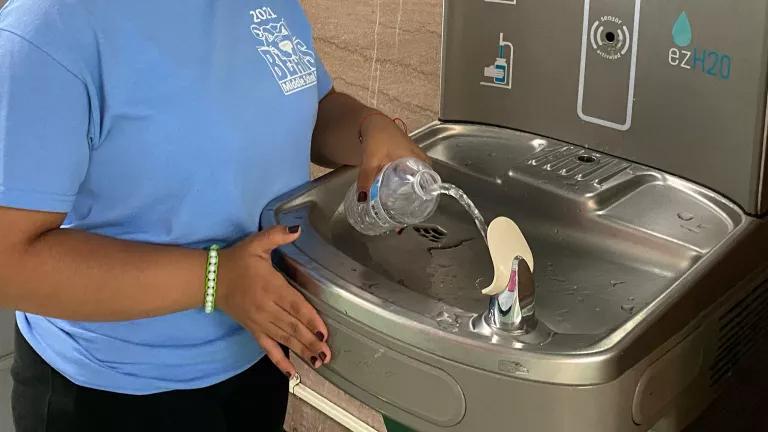Michigan Adopts Filter First Protections for Kids
The new law establishes the nation’s strongest protections against lead in drinking water at schools and childcare centers.

A student fills her water bottle from a filtered drinking fountain at Conselyea Preparatory School in Brooklyn, New York City.
Joan Matthews/NRDC
Michigan just took another major step forward in the fight to get lead out of drinking water by adopting the nation’s strongest protections for kids at schools and childcare centers. On October 19, 2023, Governor Gretchen Whitmer signed House Bill 4341 (State Representative Ranjeev Puri), House Bill 4342 (State Representative Cynthia Neeley), and Senate Bill 88 (State Senator Sylvia Santana). Soon every Michigan school and childcare center will be required to proactively install lead-removing filters at all designated drinking and cooking water outlets.
Kids spend many hours at their schools and childcare centers. Michigan law requires each school district to annually provide 1,080 hours of instruction for six hours per day over 180 days. Childcare center hours can be longer because they are aligned with parents’ full-time work schedules, which can be year-round.
While lead is toxic to everyone, infants and young children are at the greatest risk for lead poisoning because their brains and bodies are rapidly developing and more easily absorb lead than those of older children and adults. Even low levels of exposure can interfere with thought processes, lower children’s IQ, and cause attention and behavioral problems—all of which affect lifetime learning. Children with serious lead-related neurological impacts are less likely to graduate from high school and are more prone to delinquency, teen pregnancy, violent crime, and incarceration.

A junior high student fills up his water bottle at a filtered drinking fountain.
Alamy
If schools test for lead in drinking water, it is likely that lead will be found, as we’ve seen in Indiana, Michigan, New York, and other states. After lead is detected, efforts are typically made to identify the sources of the lead and, when these sources are identified, school officials often begin the expensive process of replacing plumbing, fixtures, fittings, and other components. Unfortunately, the so-called lead-free products they use as replacements still contain lead, which then reintroduces the toxic substance into the drinking water. More recently, a few states have begun requiring the installation of filters on outlets where lead was detected above a certain trigger level. While this is an improvement over the test-and-chase approach described above, it still wastes scarce dollars on lead testing rather than proactively investing in filtration at all designated drinking and cooking water outlets.
Michigan’s landmark Filter First law, which is based on NRDC’s model bill, skips this costly test-and-chase approach and goes straight to protecting kids from lead by requiring the installation of water filters at each designated drinking and cooking water outlet. In addition to being the most health protective approach, Filter First is also the most cost-effective way to protect kids from lead in drinking water as NRDC’s Filter First cost analysis demonstrates.
Michigan’s Filter First legislation was backed by NRDC and a team of public health, medical, learning disability, education, and environmental advocates who helped advance these landmark bills over the past four years. Our collective efforts resulted in strong bipartisan support for the Filter First law and an initial $50 million in state appropriation to implement the program.
In the tragic aftermath of the Flint water crisis, Michigan adopted the nation’s strongest protections for lead in drinking water and became the first state to mandate full lead service line replacements, ban partial lead service line replacements, strengthen routine lead sampling and public notification requirements, require service line inventories, and implement other protections that go beyond the federal Lead and Copper Rule requirements. With Michigan once again leading the way, NRDC will continue working with advocates in other states to support the Filter First approach so more children will be protected from lead in drinking water at schools and childcare centers.


